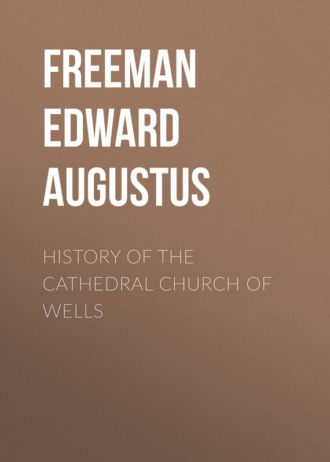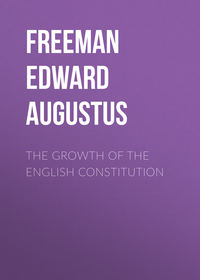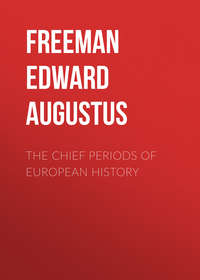 полная версия
полная версияHistory of the Cathedral Church of Wells
But we have now chiefly to see how these various changes affected the constitution and position of our church of Wells. As Wells was a secular foundation, the suppression of the monasteries did not touch it at all; Glastonbury and Bath fell, but Wells went on just as it had done before. If anything, the church of Wells gained by the suppression, as it was thereby restored to the rank which it held before the days of John de Villulâ. As I have already said, the church of Bath was suppressed along with the other monasteries, and the Chapter of Wells was once more made, by an Act of Parliament in 1543, the sole Chapter of the Somersetshire Bishoprick.142 It is undoubtedly true that, for three years, from 1537 to 1540, the Deanery was irregularly held by the King's favourite, Lord Cromwell, who, of course, as a layman, could not perform its duties.143 This was a great abuse, but it was not altogether a new abuse. To search no further, earlier in Henry's reign the two Deaneries of Exeter and Wimborne had been held at once by the King's cousin, Reginald Pole, who was afterwards Cardinal and Archbishop, but who had not then taken holy orders. Reginald Pole was, to be sure, a theological student, a description which would hardly apply to Thomas Cromwell; still Pole could as little discharge the duties of Dean of Exeter as Cromwell could discharge those of Dean of Wells.144 It was not till the reign of Edward the Sixth that the systematic picking and stealing from ecclesiastical bodies, as distinguished from their regular suppression, set in like a flood. The first instalment of destruction was indeed done in a regular and legal way. In his first year (1547), all chantries and colleges were suppressed, the cathedral chapters, the colleges in the Universities, and a few others only being spared.145 The suppression of the chantries, where masses were said for the souls of particular persons, necessarily followed on the change of doctrine; but the general suppression of Colleges, which had the effect of destroying the capitular bodies at Beverley, Wimborne, and a crowd of other places, was sheer destruction, and not reformation. Then came the general plunder of Bishopricks, Chapters, and ecclesiastical bodies generally, which began under Edward, and went on again in a form one degree less shameless under Elizabeth. A Bishop was commonly bullied into exchanging the estates of his see for some pretended equivalent, commonly in the shape of impropriate tithes. No church suffered in this way more than that of Wells. William Barlow, who became Bishop in 1547, the first year of Edward the Sixth, was driven in the course of that year and the next to give up to Edward Duke of Somerset pretty well everything belonging to the see, including the palace of Wells itself, in exchange for a few rectories.146 A large part of this property was lost for ever; but a good deal was recovered by Barlow himself after the Duke's execution, and by his successor Gilbert Bourne in the days of Queen Mary.147 It is not easy for us to conceive that there was a time when the palace had ceased to be the house of the Bishop, and had become the dwelling of a lay nobleman. And when we remember that that lay nobleman, besides receiving endless estates elsewhere, was also the grantee and the destroyer of the Abbey of Glastonbury, we get a good specimen of the way in which the property of the Church was squandered away, not for the public good in any shape, but for the private enrichment of greedy courtiers. Of the other foundations in Wells, the Priory of Saint John had fallen in 1541. This, I should explain, though its chief officer bore the title of Prior, was not a monastery, but a hospital.148 The college of Chantry-priests fell by the Act of 1547;149 the plunderers then fell upon the property of the Chapter and of its individual members. The estates of the Deanery were swallowed up, and, in order to patch up a new endowment for the Dean, an Act was passed for the suppression of the offices of Provost and Sub-Chanter, the estates of which formed a new corps for the Deanery.150 But as with the lands of the Bishoprick, so with those of the Deanery, a great part was recovered in the days of Queen Mary; so that, as the provostship and sub-chantership were never restored, I suspect that the Deans in the end gained by their spoliation. Some of the common possessions of the Chapter were also lost, and were partly recovered by Bishop Bourne, as also were the lands of the Archdeaconry; but the Archdeacon's house of which I have already spoken has remained alienated to this day.151
These are specimens of the spoliations, many of them positively illegal, all of them wrought, not for the public good but for private enrichment, which our Bishopricks, Chapters, and other ecclesiastical foundations underwent in the course of the sixteenth century. But at Wells these spoliations had an important effect on the constitution of the church. Legal cavils were raised as to the right both of the Chapter and the Vicars to their possessions. It was affirmed that the reconstitution of the Deanery had somehow involved the complete suppression of the Chapter. Both the Chapter and the College of Vicars therefore found it expedient to procure charters from Queen Elizabeth confirming them in their rights and properties. The charter granted to the Chapter is a most curious document, because it is evident that the Residentiaries took this opportunity to procure something like a legal confirmation of the usurpations by which the non-residentiary Canons were gradually cheated out of their rights and powers. The Queen refounds all the dignities and prebends, and endows them afresh with their old possessions. Then, as if the holders of these dignities and prebends did not form the Chapter, the Charter goes on to found the Chapter, as a body consisting of Residentiaries only, and to grant to them the cathedral church and other property. The deed winds up by saying that the non-residentiary Canons are to have votes in Chapter, but only for the purpose of electing a Bishop.152 I do not profess to know what may be the legal force of such a document, though it certainly seems to me that nothing short of an Act of Parliament can take away from any man or any corporation any rights which they already legally enjoy. But whatever it may be worth, this charter is the authority for the practice by which at Wells the non-residentiary Canons are summoned to the election of a Bishop and not to other meetings of the Chapter, while at York they are still summoned to every meeting. I am not a lawyer and I do not speak as one. But historically the thing is a cheat and an usurpation. The Elizabethan charter carries its own contradiction with it; and, as an ecclesiastical reformer, I say once more that the point to be most strongly insisted on, if our cathedral bodies are ever again to fulfil their ancient uses, is to make both classes of Canons realities. The Residentiaries must be Residentiaries, living on the spot, not making the cathedral a place of holiday retirement from duties elsewhere. And lest the smaller body of Residentiaries should again sink into a narrow oligarchy, the whole body of Canons must be again restored to their ancient rights, not only in the formal election of a Bishop, but in all those matters of election, patronage, discipline, and business of every kind, which are expressed in the ancient formula of "a stall in the choir and a voice in the chapter-house."153
On the two following centuries I need not dwell. I will rather hasten on to our own times. The last great changes in the church of Wells come within our own memory. Those changes say a great deal for the zeal and energy of those who carried them out, but they say very little for their taste and knowledge. The pity is that they were done at the particular time when they were done, when it was quite possible to get detail well executed – and the detail certainly is very well executed – but when ecclesiastical arrangement was not understood. It would have been far better to have let the church remain in its old state, wretched as that state was, for twenty or thirty years longer. As it was, the change was made in one sense so badly as to make the whole thing a by-word, in another sense so well that I fear there is little chance of undoing it for a good while to come. Some things were done which were deeds of sheer havoc, deeds worthy of no one but of Protector Somerset himself. What had those Bishops done whose figures may be seen in the undercroft of the Chapter-house, that they should be torn away from their places and shut up as it were in a posthumous dungeon? What had our famous Beckington done that his canopy should be carried away, and set up where, as covering nothing, it is simply ridiculous and unmeaning? To be sure even that was not the lowest depth in store for the great benefactor. His canopy had yet to be mutilated and moved backwards and forwards in order the better to display the most hideous stoves with which human perversity ever disfigured an ancient building.154 When we think of the havoc of last year, one is half inclined to forgive the havoc of twenty years back. Yet one cannot help asking why the long continuous ranges of stalls which give such dignity to the choirs of Winchester, Ely, and Manchester, were forsaken for the absurd arrangement which sticks the stalls piecemeal between the pillars, and which so lessens their numbers that, if the whole Chapter were ever to assemble, some less lucky Canons must sit on the laps of others?155 Why was all this done? I know the answer well. It was to provide room for the congregation; it was thought a great feat to give a little more width to the choir, and so to gain a few more sittings, by putting the stalls between the pillars instead of in their proper place in front of them. Now to provide for the congregation is an excellent object, but the wisdom of our forefathers had already found ample room for the congregation in quite another way. Did those who planned the last arrangements of Wells Cathedral know that there was a nave, and, if they did know it, for what end did they suppose that that nave was built? A Bishop, coming in by the cloister door, might possibly never find out that there was a nave at all; but a Dean, coming in at the west end, must have seen that there was a good deal of building between that door and his own stall, and one would have thought that he must sometimes have stopped to think for what end that building was set up. Was that long array of arches, that soaring vault, made simply as a place for rubbing shoes before the service begins or for chattering after the service is ended? I think that Robert and Jocelin had better notions of the adaptation of means to ends than to rear so great a work for such small purposes. When the last changes were made at Wells, these elementary questions seem not to have presented themselves to men's minds. Had the work waited till now, Wells might not have been, as it now is, a reproach and a proverb among the minsters of England, but we might have held our place alongside of our fellows at Chichester and Hereford and Lichfield and Llandaff. The truth, simple as it is, though it seems so strange to many minds, is that the nave of a cathedral, no less than of any other church, is nothing in the world but the place for the congregation. There is something wonderful in the kind of difficulty which some people seem to have in taking in so plain a fact. It is a thing which I have said over and over again, and people stare and seem not to know what I mean. Yet I am not putting forth any dream of my own; I am saying what is a sober fact in many other places, and what might easily be made a sober fact at Wells also. I do not ask you to go to the ends of the earth; I do not ask you even to go to places like Ely and Durham in distant parts of our island. A short trip will take you to Llandaff, and a trip a little longer will take you to Hereford, and there you will see English cathedral churches as they ought to be, but as the church of Wells is not. Enter the church of Wells, you find yourself in a vast empty space; a solid wall in front of you, with an organ on the top of it, blocks off the small part of the church which alone is used for divine worship. Into that small part, designed originally for the clergy and choir only, the whole congregation is rammed, jammed, crammed without distinction; or rather there is distinction, and too much distinction, but it is distinction wholly of the wrong kind. Can the small space in which we find ourselves be the common church of the diocese, the church of the Bishop, the church of his flock? Alas! it looks far too much like the private chapel of some half-dozen clergymen and their private friends. Think too of the burning shame of appropriated seats in a cathedral choir. The gold ring and the goodly apparel soon find their way to the chief seats of the synagogue, while the poor man in vile raiment is bidden by an unconscious irony to go and further crowd up the space which should be left void to give dignity to the approach to God's altar. Is this the way to make the whole people of the diocese feel at home in the temple which was built for them? Is this the way to strengthen a Church which seems to shrink from proclaiming itself as the Church of the People, and which seems to clutch at the shadowy dignity of being the Church of the exclusive few? Ten arches of nave stand empty, and the worshipper seeking a place has to ask, "Is this or the other person likely to come to-day?" before the spot sacred to exclusiveness may be safely intruded on. Cross the Channel, and you will see another sight. Enter by the western door of the church of Llandaff, and right before your eyes stands the altar, raised aloft in fitting majesty. Below it, open to all eyes, is the Bishop on his throne, the clergy and singers in their stalls. The long nave is filled with the people, the faithful of the city and diocese. Nothing distinguishes worshippers of higher worldly position; nothing distinguishes the households of the dignitaries of the cathedral from their fellow Christians of lower degree. There is the church as it should be;156 can we apply that name to our own church as it is? Here is the great reform; here is the one great work to be done. Make the church once more a church, before we trouble ourselves with the enrichments of the building. Make clean the inside of the cup and the platter, and the adornment of the outside may come afterwards.157 Do not misunderstand me; do not think I am asking for the wretched half-and-half mockery which is called "service in the nave." We know what that means; we see it once or twice in the year; it means a return to chaos. It means a sham altar, sham stalls, sham everything. At the very times when an unusual number of the cathedral clergy are present, it is impossible for them to take their proper places, and they are driven higgledy-piggledy into the places of the congregation. What I want is service in the nave and in the choir at once. Then comes the answer, "Oh, but it is impossible; the screen is in the way." The remedy is easy; pull the screen down.158 There are churches where so simple a remedy could not be so easily applied. In churches of the vast size of Canterbury, York, and Winchester, where also the screen is often a work of great antiquity and architectural beauty, there are no doubt real difficulties in the way of carrying out the scheme for which I am fighting. The close screen, shutting off the choir from the nave, was in its right place in a monastery, where the church really belonged to the monks, where the people were present only by sufferance, and where the monks needed some such shelter during their midnight worship. But in a cathedral church, which exists for the sake of the whole diocese, such screens were an abuse from the beginning, which ought never to have been brought in. Still we should think twice before we pulled down the ancient and splendid screens which divide the naves and choirs of some of our greater minsters. But at Wells there is no difficulty at all. The size of the church is moderate, and the screen is of no architectural value. Cut it down; why cumbereth it the ground? Break down the middle wall of partition that is against us, and let the people of the diocese of Wells again have their own church for their own. Did you not feel the lack at the last great ceremony held in this place, when our new Bishop came to take possession of his seat and to show himself as a father among his children? That ceremony, which in its very nature ought to have been done in the sight of the whole people of the diocese, could be done only in the sight of a favoured few. It was a very different sight which I saw two years back in the cathedral church of Bayeux. There I saw the installation of a new Bishop of that see, – a Bishop, I may add, who is at this moment bravely defending Gallican liberties against Roman usurpations. The rite was done in the face of the world, and the whole of that noble minster was thronged with clergy and laity from the west door to the high altar. Tell me not of impossibilities; what has been done at Lichfield and Hereford and Llandaff may be done at Wells also. I remember Llandaff a ruin; go and see for yourselves what it now is. I remember the choir of Lichfield in a far worse case than ever the choir of Wells was. I remember it blocked off from the nave, glazed and plastered, and room for the congregation found by throwing the Lady chapel into it. Go and see what the model church of England is now. "Oh, but, if we are in the nave, and if the altar is raised as it is at Llandaff, we shall not be able to see into the Lady chapel." Certainly you will not; but, of all the possible lawful and unlawful uses of a Lady chapel, that of acting as a peep-show to the choir certainly never came into the heads of its founders. But if you are not able to see the Lady chapel, you will be able to see something much better: you will be able to see what you never have seen; you will see the inside of the cathedral church itself. You will see the mighty whole, from west door to high altar, each part performing its proper function, and, as a mere view, affording a far nobler sight than the pretty peep into the eastern chapels which would be lost. And then comes another objection. "Oh, but if we are in the nave, we shall never be able to hear." Solvitur audiendo. If the officiating minister spouts or mumbles, of course you will not hear; if he chants as there is at least one among us who can chant, you might hear to the end of Saint Alban's Abbey. The light open screen, such as you see at Lichfield and Hereford, in no way hinders sight and hearing; and for those parts of the service for which chanting is unfit, for the sermon and the lessons, the preacher or reader would of course come out into the nave. The pulpit is ready for him, the lectern is ready for him, and the new device of a pulpit stuck so grotesquely opposite the Bishop's throne might, I should think, be swept away without anybody weeping for it. But from the elder pulpit, the quaint design of the seventeenth century, I will draw a lesson. It bears the legend, "Be instant in season, out of season," and instant in season, out of season, I will be, and let every one who thinks with me be also, till we have broken down the dull mass of prejudice and ignorance which stands in our way. We must work till we have given new life to what is not dead but only sleeping – till we have reformed our ancient institutions on their ancient principles – till we have swept away all traces of the days of greediness and ignorance – till pluralist Deans and non-resident Residentiaries have become things of the past – till the mother-church of the diocese has again become the church of the Bishop and the church of his flock, open to all, free to all, whose doors are never shut against any, and where every inch from western door to rood-screen stands ready for men not only to admire but to worship. Thus let us reform, lest others destroy. The true conservative is ever the true reformer, and the true reformer is ever the true conservative. If we would preserve the essence of our institutions, we must sweep away their abuses. And none of our institutions are nobler in their theory, none have more sadly fallen away in their practice, than our ancient cathedral churches. The Church of England is at this moment on her trial, and, above all her institutions, her cathedral foundations are pre-eminently on their trial. There never was a moment when a little more sleep and a little more slumber was less fitted to be the order of the day. Those who, with me, love and venerate those ancient fabrics and foundations, those who, by seeking their reformation, are thereby seeking their preservation, are bound to be up and doing. The work has begun; wherever there is a will, there is a way; many an ancient minster has put on a new garb, alike in its material fabric and in the worship carried on within it. Why should we lag behind our neighbours? Why should the mistakes of twenty years past be hung like a clog around our necks? Some needful reforms indeed could not be done without the legislative help, but it needs no Act of Parliament to make the nave of Wells Cathedral as truly a living thing, as truly a place of real and living worship, as the naves of Llandaff and Lichfield. A zeal not according to knowledge condemned us to the mischiefs of a restoration which was done too soon. Whenever zeal accompanied by knowledge appears in authority among us, as it has already appeared among others, the work will be done.
1
"Domus eleemosynaria nobilis paupertatis" is the style of the Hospital of Saint Cross near Winchester, as enlarged by Cardinal Beaufort. See the Licence of Incorporation in the Monasticon, vii. 724.
2
I refer to the debate in the House of Commons on the Scotch Reform Bill of 1868, when it was discussed whether Wells or Evesham should be disfranchised.
"Sir Lawrence Palk argued on behalf of Wells that it is 'a cathedral city of great antiquity.' This appeal on behalf of the seculars was at once met by the monastic zeal of Sir John Pakington, who daringly answered, that if Evesham 'cannot boast of a cathedral, it can of one of the most beautiful abbeys in England.' We should be sorry to suspect the good town of Evesham of any Anabaptist tendencies, but it is certain that, if it makes the boast which the member for Droitwich puts into its mouth, it belongs to the class of those who do falsely boast … Mr. Gladstone had never been at Evesham; we know of no particular call of duty likely to take him there; but Sir John Pakington, a Worcestershire man, must surely have visited a borough in his own shire. How then about the beautiful abbey, one of the most beautiful in England? Any one who has been both at Wells and at Evesham must know that Wells Cathedral is still standing, while Evesham Abbey, saving its bell-tower and a small piece of wall, has long ceased to exist. But one might ask both disputants whether Sir Lawrence Palk, in his zeal for cathedrals, would enfranchise Ely and Saint David's – whether Sir John Pakington, in his zeal for abbeys, would restore Saint Alban's and enfranchise Romsey." —Saturday Review, July 11, 1868.
3
This Lecture was given in the time between the election and installation of the present Bishop, Lord Arthur Hervey.
4
In strictness the West-Saxon Bishoprick was first placed at Dorchester in Oxfordshire in 635, and the see was not finally settled at Winchester till 670. The time between these years was one of great confusion. See Bæda, Hist. Eccl. iii. 7. Florence of Worcester, i. 235. Stubbs, Registrum Sacrum Anglicanum, 161.
5
See Bæda, v. 18, and the Chronicle A.D. 709. The first Bishop at Sherborne was Ealdhelm. See his life by William of Malmesbury in Wharton, Anglia Sacra, ii. 20.
6
See Florence of Worcester, i. 236. Will. Malm. Gesta Regum, ii. 129. Gesta Pont. in Scriptores post Bædam, 144 b; Canonicus Wellensis in Anglia Sacra, i. 554; Stubbs, 13.
7
In 710 Ine won a victory over the Cornish King Gerent; in 722 Taunton is spoken of as the town which Ine had built. This fixes the foundation of Taunton within that time. See the Chronicles under these years.
8
On this whole matter, see Anglia Sacra, i. 553, and the Historiola de Primordiis Episcopatûs Somersetensis in Hunter's Ecclesiastical Documents, p. 10. The alleged charter of Cynewulf will be found in Kemble's Codex Diplomaticus, i. 141.







